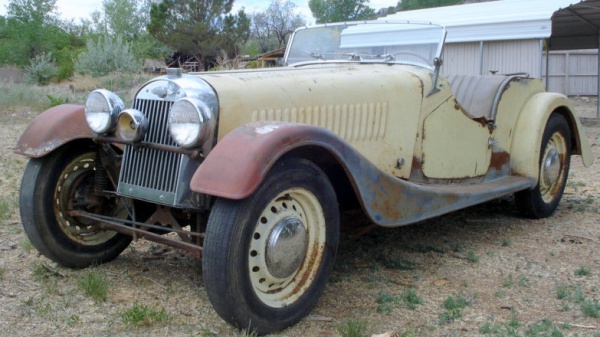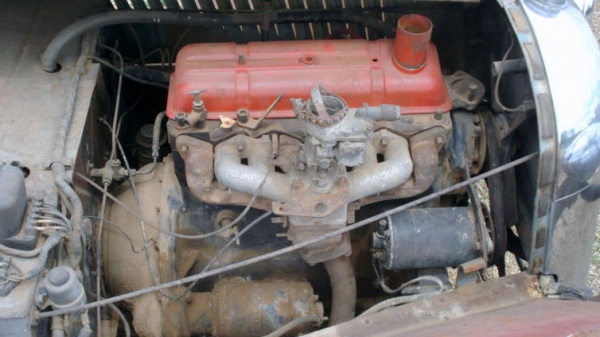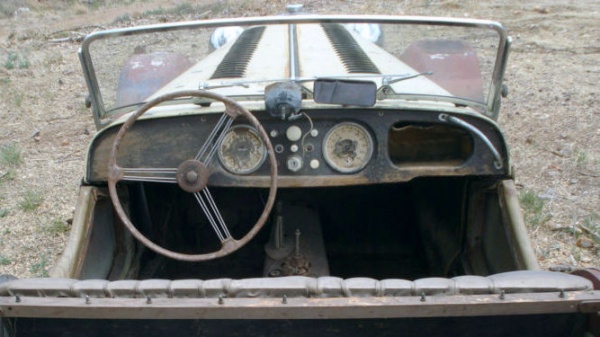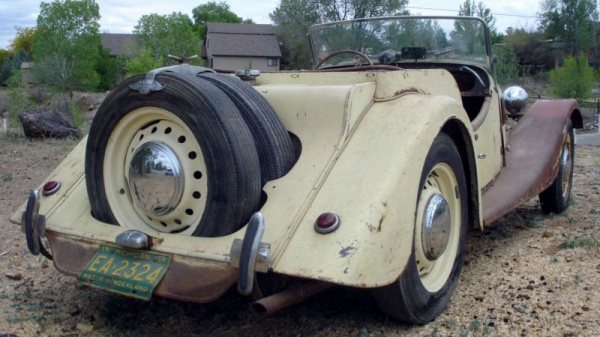
This 1953 Morgan Plus 4 Flat Nose is one of only 200 or so made with the flat radiator. When the seller found it, it had been parked in an Arizonian garage for nearly 25 years. Like the seller, the previous owner had the goal of restoring it, but never got around to it. Now that the past two owners have not been able to finish the task, the current owner feels it would be better to see this rare roadster gets into the hands of someone with the time and means to finish it. Hopefully, the old adage of “Third Time’s a Charm” comes true. Have a closer look at this project here on eBay.

The Plus 4 was introduced in 1950 as a sportier version of the 4/4. This one is obviously in need of a complete restoration, although the current look is rather interesting. It is going to be a costly and time consuming project, but the seller does have a long list of parts that are included.

There seems to be a lot of confusion about what engine was used to power the Plus 4. Morgan sourced the 2088cc inline-four from the Standard Motor Company, who also built the 2.0 liter used in the Triumph TR2. While these two engines were closely related, they were actually different blocks. This Vanguard four isn’t currently running, but it and the transmission are the original and should be salvageable.

Like the rest of the car, the interior will need a full makeover. Thankfully, there wasn’t much to these in the first place. The wood panel dash will need to be restored, along with the very rare Smith gauges. It’s surprising how intact the interior is considering it has not been cared for in the past 40 years.

Let’s keep our fingers crossed that the next owner will be able to get this rare Morgan back on the road. I would hate to see it deteriorate further, as there aren’t many of these left, especially low mileage examples with their original motors. It might not be for everyone, but in my opinion this Morgan is definitely worth saving.


it looks like good solid metal. it is worth saving at a low price to get it.
Found an all original sister of this in driver condition with only mechanicals to be done for 2500.00 10 ears ago abandoned in a storage unit. Flat rads are cool, but not for everyone.
Yes I so like the standard rad over this one, but it is what it is & it’s all there, so good luck to the seller & I hope it finds it’s way to a good home.
All Morgans are great even the three wheeled ones.
The 2088 Standard Vanguard engine powered the Triumph Roadster 2000, in 1948/49, as well as the Triumph Renown saloon. Things were changed when they started the TR line with the TR2 (the Roadster wasn’t really a sports car).
A vehicle of this vintage and exclusivity?
Patina-ed, preserved in Arizona climate?
Plus: a two-liter in a small package, wide open to the elements… pontoon fenders leading the way?
Somebody has to give this a “go”.
I like both the round and flad rad Morgans a lot, and this last-year flat-rad car is genuinely rare and should be saved. But a thorough PPI by someone knowledgeable is essential here, or there is a risk of this restoration consuming much time and cash, or maybe never getting done at all.
The description is not very clear and reassuring, unfortunately. It says ‘rust free’, but there is obvious rust on the body and frame. If you take the usual vintage car wisdom that a bit of rust on the surface usually means lots more rust underneath, then…caution is called for here. The areas under and around the doors and also the doors themselves will need very close examination for the condition of both the metal and the wood, which would be expected to have suffered in a car like this one that was stored outside under a tarp for a period of its life.
These had flexible enough frames when new, so even without rust perforation the frame might have been weakened by all-over rust to the point of being dangerous. This has meant a new frame for some 4/4s and Plus 4s over the years, and gives literal meaning to a ‘frame-off’ restoration. That means bigtime $$, and literally re-building the car from the bottom up.
There are lots of old Morgans that need restoring, some of them featured on this site, so it would be worth looking further if this one doesn’t get very good marks from a PPI.
Alan is correct about the Vanguard engine. As for the TR2 engine, the first production TR2s were built in July 1953 for auto shows in Canada and Ireland, respectively. Production of the TR2 didn’t really get well underway until about 1954, so I suspect that Morgan would’ve had little chance at the TR2 engine until 1954 (but I don’t know that for sure; maybe some Morgan folks can add more?).
More than $10,000.00 for this car or $36,000.00 for this http://cgi.ebay.com/ebaymotors/Morgan-1953-Plus-4-Flat-Radiator-Dual-spare-two-seater-british-racing-grn-brwn-4-/321121413818?ViewItem=&item=321121413818&lgeo=1&vectorid=229466&forcev4exp=true
Great example, Art: a badly neglected car that needs everything vs. a gently-used, cared-for one that was owned by someone who understands these cars.
I’ll take the British racing green car in PA and be driving the car years sooner and money ahead in the long run.
I had a chance last summer to purchase one that was a driver and rust free for a very reasonable price. All was good until I tried to sit in it………….something about a steering wheel several inches from my chest doesn’t sit well with me.
Yeah in the old days I didn’t pay much attention to it owning an MG Midget but I traded it for a Spitfire & prefered the driving position in the Spit. now after all this time I would like neither, I guess the huge SUV’s, cel phones & everyone driving with there heads in there asses, I feel the need for a bit more.
Although this British listing does not include a price I prefer 106YUM to the car on offer in PA:
http://www.prewarcar.com/index.php?option=com_caradvert&view=ad§ion_id=4&id=80293&Itemid=434
After clicking on the thumbnails, click on the larger photo(s) to enlarge once again.
Do i recall that Morgan seat bottoms had an inflateable bladder that served as the seat cushion? Yes, this one needs everything, but there can’t be more than a handful still in existence, especially LHD. I’d be tempted, but the body work and aluminum over wood is way beyond my meager skills and pocketbook. Good comment on the frame rust, safety is a big item with structural strength issues.
I’ve met the seller in the past and purchased parts from him. I would purchase from him again, if I had to, but he’s not my first choice of someone to deal with.
He sells parts and unrestored cars, so this may or may not have been bought with the intention of restoring. Be assured that the seller has a good understanding of the cost of restorations.
His attitude when buying is that what you have is worthless junk, but when he’s selling it, it’s rare and valuable. In this case, the Morgan is rare and valuable.
aren’t most of them like that.
60 minutes left and the bid is $13,333. Seems like it’s climbing into territory where it will be hard for a buyer to restore it and not end up upside down regarding its final restored value unless he does all the work himself. There aren’t many things on the car that don’t need some sort of attention. There are a couple of upgrades any buyer ought to strongly consider — 1-3/4″ front drum brakes off a later car to replace the 1-1/4″ items on the car now, and later ball-joint type tie rod ends instead of the type now on the car (both of these are visible in the photos of the PA car, which appears to have a TR motor but otherwise looks close to original). The radiator will prove difficult to restore if the new owner wants it chromed, unless a separate radiator shell is used, leaving the original chrome exterior as only a shell. If those are the original 16″ wheels, tire choices are limited. A TR engine is not uncommon to see in these cars, and its performance has long been recognized as superior to the Vanguard unit when comparing two stock engines. The TR2 unit was introduced just after Morgan quit producing the flat-radiator model and many were quickly retrofitted into earlier cars. Few successful racing flat-rad Morgans had the Vanguard, which was typically not competitive against other engines of similar capacity, although an Australian bloke led the way, reportedly teaching the Triumph factory mechanics enough to proceed successfully with engineering the TR2 engine.
Most Morgan 2-seaters were fitted with Moseley Float-on-Air cushions (4-seaters had springs in the front seat frames) but few sport them today. Modern replacements are available for those that must have the air cushions and they no doubt last a lot longer.
A surprising number of these (along with other later types of Morgans) remain in service since Morgans are endlessly rebuildable. Need a new chassis? No problem; call Don Simpkins. Need a new body tub, complete with wood and sheet metal? No problem — the Morgan factory will send you a new one, probably cheaper than you can have one built in the US. Including my car, there are at least five of these racing in vintage classes in the US (and the larger, later drum brakes work just fine under racing conditions). It does help tremendously to get plugged in with other Morgan owners and specialists.
Not sold at the high bid of $13,535
To quote my favourite SCM analyst:
“The money should have been enough to buy it”
So it sits for another 25 years and becomes even more valuable? Duncan’s comments on parts for Morgans surprised me. A car company that actually cares about their cars once it is out the door? My interest in Morgan’s keeps growing. Neat cars with a great history.